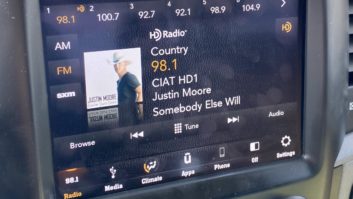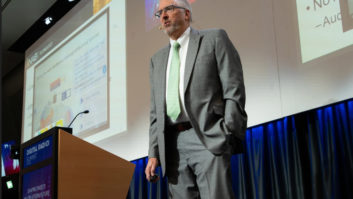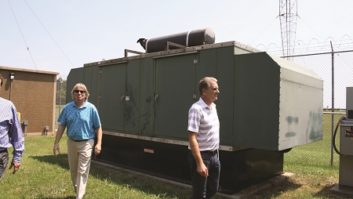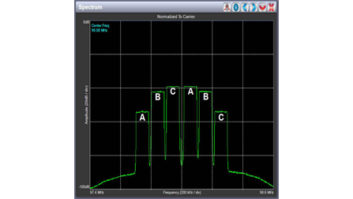Developer of Split-Level Combining Touts Its Energy and Space Efficiencies
HD Radio is catching on and starting to spread across the country; however, several issues have caused many stations to delay implementation. These include a lack of physical space in the transmitter room, replacement of an existing transmitter, increased HVAC demands and a higher power bill.
These issues are all caused by an inefficient and cumbersome combining system, which has produced a challenge to “find a better way.”
The new split-level combining answers the call.
Traditional combining challenges
Each of the three current methods of combining comes with its own set of challenges. Low-level combining works well, but only at lower power levels due to the cost of the linear solid-state transmitters.
High-level combining can be used at any power level by combining the outputs of two transmitters, one analog and one digital, through a 10 dB hybrid. Unfortunately, with this method 10 percent of output of the analog transmitter is lost into a reject load, and 90 percent of the digital transmitter’s output power is lost.
It is common for this reject power level to be 3,000 watts to 9,000 watts, turning this load into an expensive space heater. This can put a strain on any HVAC system, and adds up to a higher power bill.
To add to the hardship of this method, radio stations will be forced to turn up the power on their existing analog transmitter to compensate for losses in the combining system. If the radio station already is pushing its transmitter to the limit, it will be forced to purchase a new, higher-power model.
(click thumbnail)Fig. 1: Generic layout for split-level combining. There are several values for the hybrid, part of the flexibility of the system.
(click thumbnail)Fig. 2: Example of an IBOC system using high-level combining with 10 kW TPO. Compare to Fig. 3 on page 15.
(click thumbnail)Fig. 3: The scenario shown in Fig. 2, using split-level combining. Notice the reduction of power to the reject load.
The third and more recent method of combining is through the use of dual antennas, using a second antenna for the digital signal. This method is efficient and attractive for stations that already have an auxiliary antenna licensed and mounted on the same tower as their main. For other stations, it requires installation of a new antenna and transmission line, which could be costly and may incur additional monthly tower rental fees.
Another issue with the dual antenna method is that the propagation of the two signals will not match. In fact, this method is not permissible for directional FM radio stations. This is of particular interest to public radio stations, as many of them require directional antennas.
Another headache for broadcasters is lack of physical space. Transmitter buildings are not known as spacious.
Both the high-level and dual antenna combining methods require installation of a new transmitter while the old main and aux transmitters must remain in the space. Without the proper space, stations using these methods could be faced with having to expand their buildings, putting an even bigger strain on the implementation budget.
Split-level combining
Harris RF Design Engineer George Cabrera and I have found that better way. The patents-pending technology, called split-level combining, addresses these problems.
Advantages of Split-Level CombiningHigher efficiency
Less expensive to install
Lower operating costs
No need to replace or upgrade existing FM transmitter
Provides backup FM analog signal
Uses existing antenna system
Optimum digital / analog signal tracking
Fits in most existing buildings
Lower HVAC Requirements
Increased tube life
High-level combining is inefficient because the output signals of the two transmitters are so different. Split-level combining takes advantage of the ability to add an analog signal component to the digital transmitter. Now, with both transmitters carrying a portion of the analog signal, the outputs more closely match, reducing the losses sent to the reject load.
We tested split-level combining on WPYO(FM) in Orlando in April. Operating with a TPO of 7.3 kW analog and 73 watts digital, the reject power level dropped from 1,560 watts in the high-level combining mode, down to 73 watts with split-level combining.
Both the analog and digital transmitters produced 3,650 watts of analog signal, eliminating all of the analog signal losses. Because the digital signal was present only in the digital transmitter side, it did still see a 50 percent loss.
The digital signal was set at 146 watts to compensate for the loss. Since the WPYO TPO is low, the station could operate in the low-level combining mode; however efficiency improvements can still be realized through the split-level mode.
Digital transmitters must run in a less-efficient Class AB mode in order to provide the linearity necessary to carry the digital carrier. Because of this, we can carry 50 percent of the analog signal through the Class C amplifier, recovering even some of those losses.
At higher power levels, the savings realized through split-level combining become more substantial. At a TPO of 15,000 watts, for example, the power to the reject load will drop from approximately 3,200 watts down to about 150. With this amount of reduction, the reject load can remain inside of the building without worries of overloading the HVAC system.
Another benefit is reduction of operating costs. With the improved efficiency, which could range from 5 to 25 percent, a radio station can save hundreds of dollars each month in its power bill as compared to a high-level combined system. Your electric bill will still rise once your station goes digital, but not as much as it would have with high-level combining.
In the example with 15,000 watts TPO, the average savings should be around $400 per month. The savings will vary depending on power costs in your area.
Split-level combining can be used for virtually any transmitter power level. The combining system has several variables that will allow improvements in efficiencies even with very high TPOs.
The system has patents pending, and Harris is selling it. The company’s application engineers can help determine the setup for station needs.
Lowered costs
One of the big advantages of split-level combining is the ability to reduce the cost to convert a radio station to digital. Because the digital transmitter is now handling some of the analog signal, you no longer need to increase the output power of your existing transmitter.
Many stations that were faced with replacing a perfectly good transmitter can save that expense. In fact, the power output level of your analog transmitter will actually be reduced, thus increasing your tube life and saving more on your operating costs.
If space in the transmitter building was an issue, split-level combining can help there as well. Once again, because the digital transmitter carries an analog component, it can become a lower-power backup transmitter in an emergency and keep you on the air, allowing you to remove your old auxiliary transmitter to make room for the new one. You may even find you have more space available in the transmitter building now.
Customizing
The split-level combining system has flexibility in its configurations. Slight changes in the combining ratio can make a huge difference in the installation costs.
For example, if a station with a high TPO decides to give up a slight amount of the efficiency, that station may find that a smaller digital transmitter can be used, which in some cases could save tens of thousands of dollars in the installation costs.
RW welcomes other points of view.














